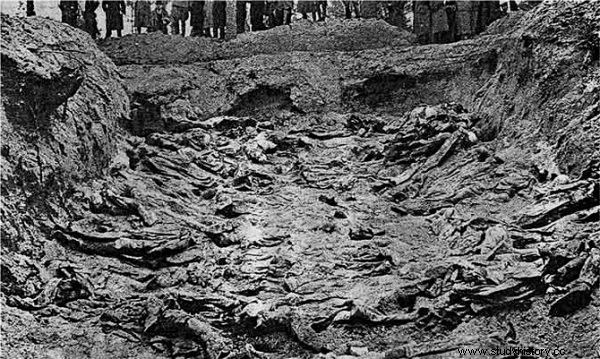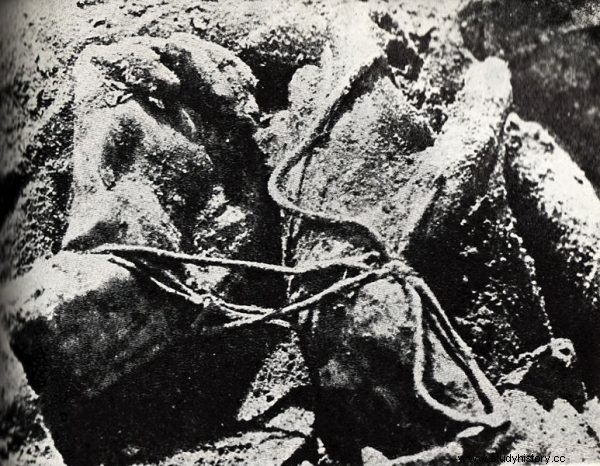This is one of the most tragic aspects of the Katyn massacre. The Poles, who were later murdered by the Soviets, were imprisoned in officer POW camps near Kozielsk, Ostaszków and Starobielsk to find themselves in the first transports to the place of execution. How is that possible?
On the basis of Stalin's decision of March 5, 1940, within two months - in April and May - the Soviets murdered over twenty thousand Polish officers, teachers, officials, uniformed and clergy. Previously, most of the victims had passed through the POW camps near Kozielsk, Starobielsk and Ostaszków.
The conditions in these centers were dramatic. Hungry, sick, repeatedly interrogated and forced to work prisoners there were regularly brainwashed by Soviet propaganda. Still, they caught every chance of survival. So why were they so eager to die during the deportations?
First come, first served?
To this day, few accounts of the life of the prisoners of the Katyn massacre in the Soviet camps have survived. The ones we know, however, are shocking. They show that when the deportations began, the prisoners were even pushed into the arms of death. In his book "Księża z Katyn", Patryk Pleskot relates:"The officers were eager to leave, they tried to find themselves in the first transports; the sick and injured pretended to be healthy, just to get to a seat in the wagon ”. How is that possible?
The researchers emphasize that this could also be due to the natural tendency of the human psyche to ignore worst-case scenarios. A significant role was also played by the hay by the Russians of disinformation, as well as propaganda, with the help of which the perpetrators tried to "soften" their victims. In "Księży z Katyn", Patryk Pleskot explains:
The Soviets, using skillfully dosed rumors (also with the use of an espionage network), influenced the opinions of prisoners about their future.
Not all the rumors, formulated after the deportations had started, that officers would be handed over to the Germans or handed over to neutral countries (which would be the best solution) appeared spontaneously. The Soviets also tried to prevent the word "murder" from being used anywhere.

Mass grave of officers - exhumation 1943
It is possible, therefore, that the Polish officers simply hoped until the very end that their fate would turn around and regain their freedom (or at least they would be taken over by a more "civilized" enemy, as the Nazis still perceived at the time). Some of them, however, must have realized how they might end up. So why wasn't anyone putting up much resistance?
As far as possible from the camp
Patryk Pleskot concludes gloomily:“Each change seemed better than the nightmarish life of the camp. In retrospect, we know perfectly well that not all of them. " What was the everyday life of the inmates like? In the camp in Starobelsk, they were kept in barracks - infested with lice, densely built up with bunks.
In the wooden building number 8, although the ceiling was only 2.5 meters high, the Soviets stuffed three-story "beds" (although in fact it is difficult to call such small shelves 35-40 centimeters wide and only 1.5 meters long). And there was no room anyway, and some of the prisoners had to lie directly on the muddy floor.
The main memory of the survivors, however, was not the crowds, or even the vermin spreading everywhere, but the overwhelming hunger. As we read in the book "Księża z Katyn":
As for the food, the rules were as follows:you got a portion of stale wholemeal bread (about 200 grams), a little marmalade, and "coffee". As a rule, such a set had to be divided among several prisoners. Lunch was replaced by a poor potato or porridge, a piece of fish, and dinner was replaced by cereal coffee.
Once a week, the prisoners were to receive a modest ration of tea, some sugar and a cube of tobacco. However, it is not entirely certain how these top-down recommendations were implemented in practice.
Another problem was the lack of water - there was more mud in the camp's well than life-giving fluid. The Soviets ordered a second hole to be dug, but it turned out to be too shallow, so the water was running low again.

Katyn knot - hands tied on the victim's back
Exhausted prisoners, bitten by bedbugs and lice, were prone to infectious diseases. Dysentery (dysentery) was spreading among prisoners, and there were also cases of typhus. An epidemic would have been inevitable were it not for the fact that the NKVD were afraid to get infected themselves, so they agreed to carry out a vaccination campaign. It is therefore not surprising that as soon as there was any hope of leaving the camp, the prisoners preferred not to think about the potential destination, and focused only on changing the current situation.
From the rain into the gutter
The very method of transporting them also acted to their disadvantage. When on April 5, 1940, a decision was made to start razgruzka, i.e. to "unload" the Starobiel camp, the prisoners were only informed that they would be transported to three transport junctions (in Kharkiv, Kiev and Smolensk), and from there they would go further west - to the territories occupied by the Germans be occupied by the Russians of the former frontiers of the Second Polish Republic.
At one time, from several dozen to two hundred and several dozen inmates were sent to the transports (often this number was a multiple of 65, because so many people could fit in one prison car). It was difficult to identify any particular selection method. Decision-makers in Moscow seemed to choose names at random, without a key, although they tried to keep the proportions of officers of various ranks and civilians on individual lists - so that roughly the same number of people was systematically dropping from each block.
The "chosen ones" were led out of the camp one by one, through a small guardhouse. The guards made sure that they did not communicate in any way with other prisoners. A transport convoy, invisible from the outpost, waited outside the gate. The victims entering the wagons did not even realize that they were going to the slaughter.
The killing itself was perfectly organized by the Soviets. There were already ditches waiting for the convicts. The torturers did not give them any time to react. Most of the victims died from a single shot to the back of the head. Only some of the bodies showed signs of struggle or overpowering. As Patryk Pleskot sums up:
In October 1940, one hundred and several dozen NKVD officers - men and women - received awards for preparing and organizing the Katyn massacre.
We do not know how many of them shot at Polish officers. It can be precisely determined that the financial gratification was the equivalent of the price of two kilograms of bread. This is what the lives of the murdered Poles were worth for the Stalinist regime.
